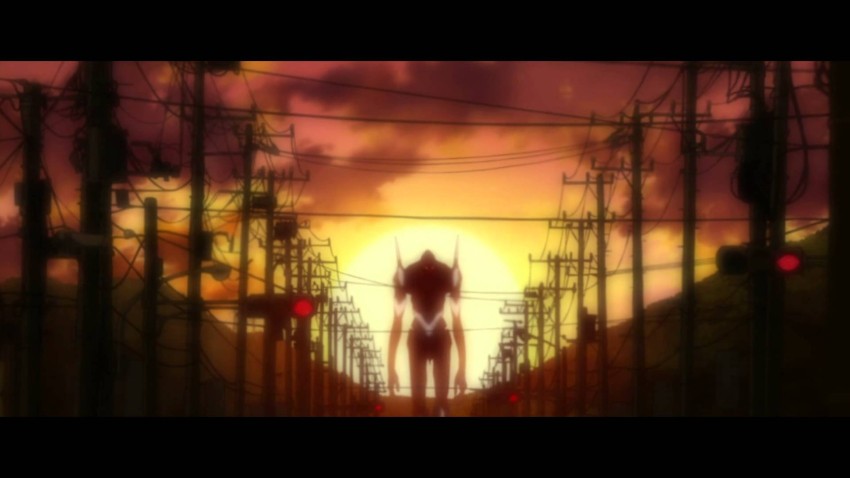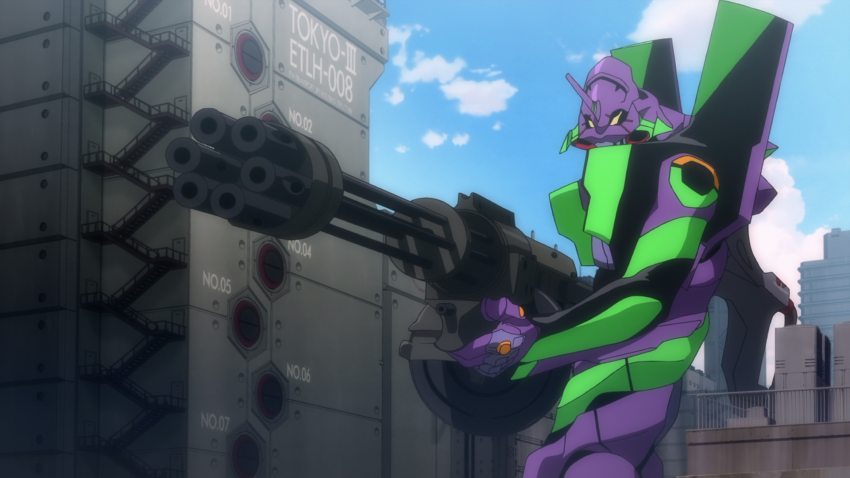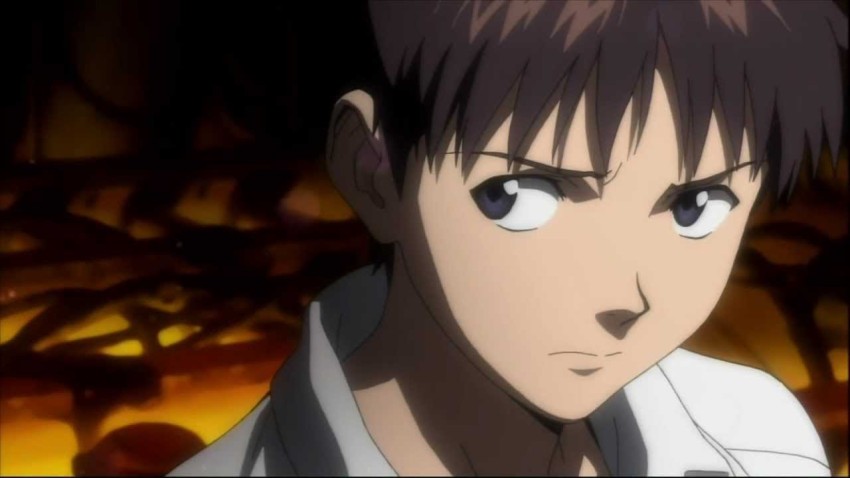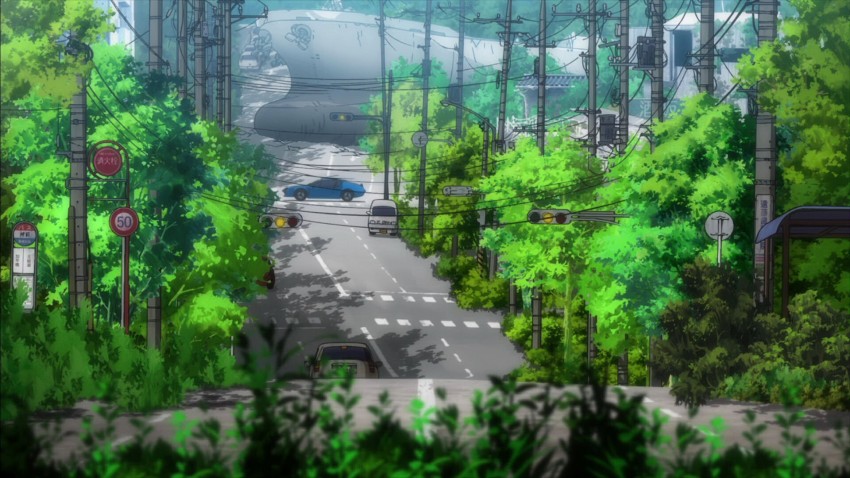Evangelion 1.11
April 21, 2017 · 2 comments
By Andrew Osmond.  In September 2007 I was in Tokyo at the so-called “Cinema Square” in the Shinjuku district. I saw fans queuing for one of the first screenings of the science-fiction/action film, Evangelion 1.0: You Are (Not) Alone. The film was revised a bit for its home release, and renamed Evangelion 1.11; it’s this version which Anime Limited is bringing out in a new edition.
In September 2007 I was in Tokyo at the so-called “Cinema Square” in the Shinjuku district. I saw fans queuing for one of the first screenings of the science-fiction/action film, Evangelion 1.0: You Are (Not) Alone. The film was revised a bit for its home release, and renamed Evangelion 1.11; it’s this version which Anime Limited is bringing out in a new edition.
On that Tokyo morning, a legion of cheery fans filed in orderly Japanese fashion around the square, while in the cinema it was standing-room only. Despite Evangelion’s reputation as an “otaku” anime (its motto was “service, service, service!”), the crowd looked positively mainstream. There were a few exceptions, though, including two girls in school uniforms and coloured wigs, and a goateed lookalike of Evangelion’s feted creator, Hideaki Anno. No prizes for guessing who the paparazzi homed in on… Sorry, Anno!
Evangelion 1.0, or 1.11, marked a new start for the Evangelion franchise. It’s fair to call the film a reboot, though there are sly hints for old-time fans that it might be much more than that. But it’s also designed as a jumping-on point for viewers who’ve never seen Evangelion before.
 For anyone who doesn’t know the story, Eva is about a neurotic young boy, 14-year old Shinji. In a near-future Japan, Shinji is forced to pilot an artificial giant – the titular Evangelion – against huge monstrosities who threaten humanity. The boy-and-big-bot pairing is a decades-old anime template; it goes back to 1970s shows like Go Nagai’s Mazinger Z (and was lovingly homaged by Guillermo del Toro’s Pacific Rim). But Shinji isn’t fired up by fighting giants; rather he’s a miserable, scared screw-up.
For anyone who doesn’t know the story, Eva is about a neurotic young boy, 14-year old Shinji. In a near-future Japan, Shinji is forced to pilot an artificial giant – the titular Evangelion – against huge monstrosities who threaten humanity. The boy-and-big-bot pairing is a decades-old anime template; it goes back to 1970s shows like Go Nagai’s Mazinger Z (and was lovingly homaged by Guillermo del Toro’s Pacific Rim). But Shinji isn’t fired up by fighting giants; rather he’s a miserable, scared screw-up.
Evangelion highlights the tormented psychology of its characters – not just the wussy Shinji, but the others who surround him in the Eva project. But this is also a hell of an action film. Within the first two minutes, Shinji finds himself in the middle of a stupendous monster attack, with exploding helicopters and swarms of missiles. Then he’s stuffed into a car by a beautiful woman (his new guardian Misato), while the action revs up and up.
Much has been written on Eva’s mishmash of inspirations. They range from Japan’s Ultraman series (where a giant hero fights monsters), to Anno’s personal issues (many fans read Shinji as Anno), to the oeuvre of Gerry Anderson. Eva 1.11 has the extraordinary image of an entire city that can be “retracted” underground, skyscrapers descending smoothly into their basements when the monsters approach, or rising again when it’s all clear. It’s like Thunderbirds’ Tracy Island writ very large.
In Britain, Eva is one of anime’s crucial gateway titles, a thrilling introduction to bombastic action, provocative themes and time-out goofing. The original television Eva was often visually superb, especially in its designs and art direction, but had the limitations of a TV budget. The film Eva 1.11 looks… well, dazzling.
 CG puts Shinji at the centre of his gleaming Eva steed, while the rising and falling of the Thunderbirds-ish city is a spectacle to make mecha fans weep. All the monsters (“Angels”) are revised from their TV incarnations. The last of them is an azure cube which twists through geometries while emitting a terrifying, inhuman scream. Called Ramiel, it’s an extraordinary creation, more horror than fantasy, and a landmark of cinema anime.
CG puts Shinji at the centre of his gleaming Eva steed, while the rising and falling of the Thunderbirds-ish city is a spectacle to make mecha fans weep. All the monsters (“Angels”) are revised from their TV incarnations. The last of them is an azure cube which twists through geometries while emitting a terrifying, inhuman scream. Called Ramiel, it’s an extraordinary creation, more horror than fantasy, and a landmark of cinema anime.
The tactics that the characters use to fight Ramiel – basically, feeding Shinji the entire electrical output of Japan – are also notable. Indeed, they inspired a meme (“Operation Yashima”) on Japan’s social media after the 2011 Tohoku earthquake, when there was a real nationwide energy crisis. Instead of elite superheroes “acting as one” to save humanity, Eva suggests the whole Japanese nation could act in concert against the monsters. There’s a comparable last battle in Anno’s live-action monster film Shin Godzilla, released in Japan last year.
Eva 1.11 adapts the first six episodes of the original TV series, which were originally made back in the 1990s. Whereas the TV version was made by the Gainax studio, the film was made by a new outfit, khara (styled as lower-case), founded by Anno in 2006. In one talk, Anno said he considered blowing up Eva’s TV animation to 16mm film, but realised that wouldn’t work; the TV lines would look too thick on a cinema screen. Consequently, the animation was completely recreated, and massively revised, by many of the same artists who had worked on Eva for TV. For example, the animator Takeshi Honda, who we interviewed recently, worked on both the TV and film versions.
The film follows most of the same story beats, but with a faster pace to make it function as a movie. An illustration is how the film changes the second TV episode, showing Shinji’s first battle. In the TV version, the series plays an audacious trick. In the middle of the battle, when Shinji seems doomed, there’s a sudden cut to… the characters going about their business in the next day, leaving us wondering how on earth Shinji survived. We’re finally shown the answer in a flashback at the end of the episode. This trick worked brilliantly in an episodic series, but it wouldn’t have worked nearly so well in a film’s first act. Presumably for that reason, the film presents the action chronologically instead.
 There are other changes between the TV series and the film, such as shortening Shinji’s “walkabout” when he goes AWOL from monster-fighting, though the sequence still conveys his emotional imprisonment. Later, there’s a very telling new scene where Misato shows Shinji what lurks in the caverns under the city. If you’ve seen the TV series, this new scene will feel like a Mario Bros short cut to a scene it should have taken Shinji hours to reach!
There are other changes between the TV series and the film, such as shortening Shinji’s “walkabout” when he goes AWOL from monster-fighting, though the sequence still conveys his emotional imprisonment. Later, there’s a very telling new scene where Misato shows Shinji what lurks in the caverns under the city. If you’ve seen the TV series, this new scene will feel like a Mario Bros short cut to a scene it should have taken Shinji hours to reach!
The film’s climax ramps up the character melodrama more than the TV version. Fans of the original might criticise the finale as feeling more like Shonen Jump than Eva, but it’s a sound call. This is the crescendo to a movie, remember, not just a TV battle of the week. The change in tone also hints that the new Evangelion movies won’t just be the Eva as seen on TV. This would be borne out spectacularly in the second and third films after Evangelion 1.11, which take the story in wildly new directions, far beyond the small screen.
But don’t dismiss Eva 1.11 as a TV remake or a Lucas-style “Special Edition.” It’s a terrific work in its own right, a fact that’s clearer now there’s a decade’s distance from its first release. Rewatch the film in 2017, and marvel at how it has hardly aged a day.
Evangelion 1.11 is released on UK Blu-ray by Anime Limited.
Mateusz Pluta
April 24, 2017 10:46 am
Hello there, I love this release! Already on my shelf next to escaflowne collector's edition. When can we expect 2.22 and 3.33 ?
Mateusz Pluta
April 24, 2017 10:47 am
And what about release tv series on BD?